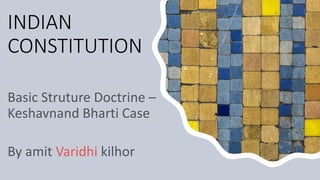
polity13BasicStructure.pptx
- 3. Basic Struture Doctrine – Keshavnand Bharti Case Indian Constitution - Polity
- 5. • The Supreme Court's initial position on constitutional amendments was that no part of the Constitution was unamendable and that the Parliament might, by passing a Constitution Amendment Act in compliance with the requirements of article 368, amend any provision of the Constitution, including the Fundamental Rights and article 368. In Shankari Prasad Singh Deo v. Union of India (AIR. 1951 SC 458), the Supreme Court unanimously held, "The terms of article 368 are perfectly general and empower Parliament to amend the Constitution without any exception whatever.
- 8. • But in the Golak Nath case2 (1967), the Supreme Court reversed its earlier stand. In that case, the constitutional validity of the Seventeenth Amendment Act (1964), which inserted certain state acts in the Ninth Schedule, was challenged. The Supreme Court ruled that the Fundamental Rights are given a ‘transcendental and immutable’ position and hence, the Parliament cannot abridge or take away any of these rights. A constitutional amendment act is also a law within the meaning of Article 13 and hence, would be void for violating any of the Fundamental Rights.
- 9. •The Parliament reacted to the Supreme Court’s judgement in the Golak Nath case (1967) by enacting the 24th Amendment Act (1971). This Act amended Articles 13 and 368. It declared that the Parliament has the power to abridge or take away any of the Fundamental Rights under Article 368 and such an act will not be a law under the meaning of Article 13
- 10. • However, in the Kesavananda Bharati case (1973), the Supreme Court overruled its judgement in the Golak Nath case (1967). It upheld the validity of the 24th Amendment Act (1971) and stated that Parliament is empowered to abridge or take away any of the Fundamental Rights. At the same time, it laid down a new doctrine of the ‘basic structure’ (or ‘basic features’) of the Constitution. It ruled that the constituent power of Parliament under Article 368 does not enable it to alter the ‘basic structure’ of the Constitution. This means that the Parliament cannot abridge or take away a Fundamental Right that forms a part of the ‘basic structure’ of the Constitution.
- 11. •Again, the Parliament reacted to this judicially innovated doctrine of ‘basic structure’ by enacting the 42nd Amendment Act (1976). This Act amended Article 368 and declared that there is no limitation on the constituent power of Parliament and no amendment can be questioned in any court on any ground including that of the contravention of any of the Fundamental Rights.
- 12. However, the Supreme Court in the Minerva Mills case (1980) invalidated this provision as it excluded judicial review which is a ‘basic feature’ of the Constitution. Applying the doctrine of ‘basic structure’ with respect to Article 368, the court held that: “Since the Constitution had conferred a limited amending power on the Parliament, the Parliament cannot under the exercise of that limited power enlarge that very power into an absolute power. Indeed, a limited amending power is one of the basic features of the Constitution and, therefore, the limitations on that power cannot be destroyed. In other words, Parliament cannot, under article 368, expand its amending power so as to acquire for itself the right to repeal or abrogate the Constitution or to destroy its basic features
- 13. • Again in the Waman Rao case (1981), the Supreme Court adhered to the doctrine of the ‘basic structure’ and further clarified that it would apply to constitutional amendments enacted after April 24, 1973 (i.e., the date of the judgement in the Kesavananda Bharati case)
- 14. The present position is that the Parliament under Article 368 can amend any part of the Constitution including the Fundamental Rights but without affecting the ‘basic structure’ of the Constitution. However, the Supreme Court is yet to define or clarify as to what constitutes the ‘basic structure’ of the Constitution. From the various judgements, the following have emerged as ‘basic features’ of the Constitution or elements of the ‘basic structure’ of the constitution:
- 15. 1. Supremacy of the Constitution 2. Sovereign, democratic and republican nature of the Indian polity 3. Secular character of the Constitution 4. Separation of powers between the legislature, the executive and the judiciary 5. Federal character of the Constitution 6. Unity and integrity of the nation 7. Welfare state (socio-economic justice) 8. Judicial review 9. Freedom and dignity of the individual 10.Parliamentary system 11.Rule of law